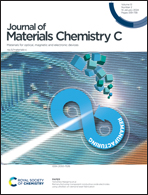Translating efficient fluorescence into persistent room-temperature phosphorescence by doping bipolar fluorophores into polar polymer matrix†
Abstract
In polymer-based phosphorescent films, the rigidity of the polymer matrices has been highlighted; however, the effect of the polarity of the matrix on persistent room-temperature phosphorescence (pRTP) has received less attention. Herein, polar coumarin derivatives with intramolecular charge transfer (ICT) characteristics were doped into polymer matrices to achieve pRTP. It was discovered that intense phosphorescence emission can be observed in highly polar matrices such as polyacrylic acid (PAA), polyvinyl alcohol and polyacrylonitrile, while no phosphorescence was observed in moderately polar polymethyl methacrylate and nonpolar polystyrene. PAA was found to be the most efficient matrix among the investigated polymers and the phosphorescence lifetime reached up to 1 s for 7-AMCum@PAA. The 7-DEAMCum@PAA phosphorescent film exhibited a long lifetime of 711 ms and a high phosphorescence quantum yield of 31.29%. We propose that the dipole–dipole interaction between the polar fluorophore and polar matrix can stabilize the single charge transfer (1CT) excited state under photoirradiation, which facilitates spin–orbit charge transfer-intersystem crossing (SOCT-ISC). The resulting triplet state can be stabilized by a rigid polymer matrix network. Thus, efficient room-temperature phosphorescence emissions can be achieved. This study not only provides a strategy for achieving persistent room-temperature phosphorescence of coumarin derivatives but also provides a clue for designing and constructing phosphorescent materials by doping bipolar fluorophores into polar matrices.



 Please wait while we load your content...
Please wait while we load your content...